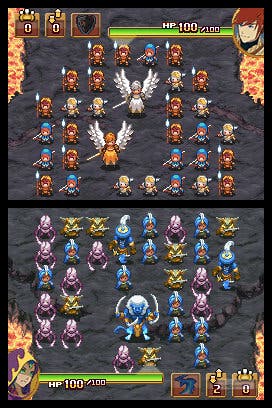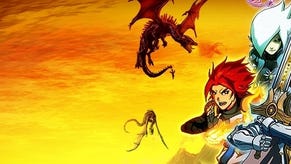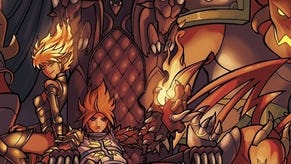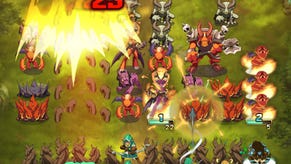Might & Magic: Clash of Heroes
The thin green, blue and yellow lines.
When a venerable series makes the transition to handheld, a number of things can happen. Sometimes the results are excellent, paring down game concepts to their essential core, stripping away the layers of gloss and varnish to reveal the beautiful grain of the fun-wood beneath. Sometimes the result is less auspicious, with shoehorned gimmicks and unnecessarily hamstrung gameplay.
Either way, for some fans, seeing a handheld version of a much beloved series crop up on a release list is tantamount to sacrilege - a bastardised 'kids version' which will only serve to defile the altar of their particular icon. Initial impressions of Might & Magic DS will certainly evoke this sort of resentment in some, but a little time with the chibi-cised Elves and Daemons of Clash of Heroes is likely to soften all but the least charitable of hearts.
But the shift in artistic direction isn't the seachange here, nor what's most likely to raise the odd hardcore eyebrow - Clash of Heroes forgoes the usual strategic, chess-like battle system in favour of a puzzle RPG mechanic. Sure, you'll still be traipsing around woods, mountains and plains of the netherworld, gathering troops and taking on enemies to progress, but the rank and file of your army has been replaced by, well, rows and columns.
Battles take place on a grid, with the top screen occupied by enemy soldiers and the touch-screen by your own. There are three basic categories of troops: regular, elite and champion. Regular troops take up one square of the combat grid, whilst elites occupy two in a column and champions a square four. When each battle begins, troops are randomly dropped into the grid and a number of action points are allocated to each player. Units at the near end of a stack can be picked up and dropped into a new column, or specific units can be removed, letting those above them 'fall' towards the centre line, each action costing a point each.

Stack three regulars in a column and they'll start a countdown timer for their attack. Elites need two regulars behind them, champions four - their attacks take much longer to count down, but are far more powerful as a result. Once the attack is completed - usually a projectile or a charge up the screen by the troops themselves - the attacker tends to disappear from the field, returning to a pool of reinforcements activated by a shoulder button, also costing an action point.
When units attack they will first attack any units directly above them, with any remaining attack power being channelled into the opposing general's 'zone', doing direct damage to their HP when they reach the top of the screen. Deplete your opponent's HP and it's time for the victory dance.








